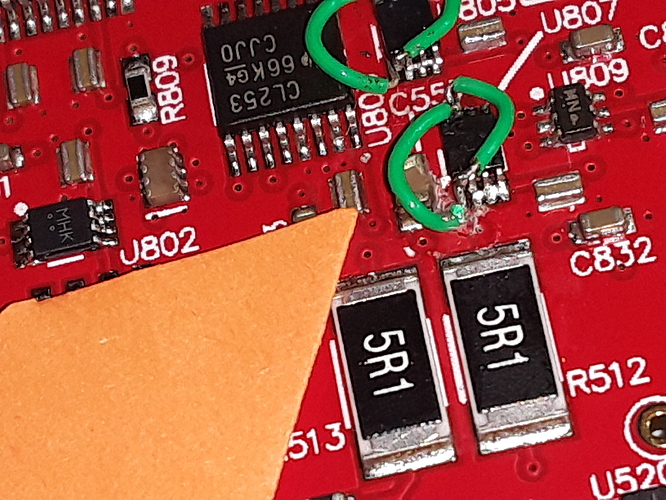Yes, I heard a Dartzeel / Focal Utopia system, and the recording location feel was amazing.
Maybe the Dartzeel treble « danalogue » dac ?
If Ted can improve that, the DS would be even more amazing.
This whole discussion seems to have gone silent… I’m curious as to why.
Because no one has posted in the thread. ![]()
And as Paul said above…
It’s kind of the opposite: if I knew I’d take so long I wouldn’t have started this thread as early ![]() I don’t like talking about things that may or may not happen. On the other hand the TSS will happen and I like what I’ve heard, measured, debugged so far. When the next new features are working I’ll talk about them here. But I really like the schematics and layout of the new boards - I’ve taken the time to address some things that bothered me a little in the back of my mind.
I don’t like talking about things that may or may not happen. On the other hand the TSS will happen and I like what I’ve heard, measured, debugged so far. When the next new features are working I’ll talk about them here. But I really like the schematics and layout of the new boards - I’ve taken the time to address some things that bothered me a little in the back of my mind.
It has been an enjoyable thread. I am happy to wait until there is more to report.
Now you’re just teasing us. ![]()
Everything I do is surface mount (which helps with noise.) I usually find the quality of components I need without going to boutique parts. (If you are doing production runs, you don’t want supply chain problems.)
Bypass caps are just the tip of the iceberg. If you don’t generate noise on the first place that helps. Multiple levels of regulation with quality regulators is good. Good routing is a must. (I like that JA noted that care must have been taken in the layout of the DS based on his measurements.) The list goes on and on. Noise is in the front of my mind at every juncture.
You must be having an incredible amount of fun!
That must be the reason Ted continues to work on our next firmware!!!
Hey @jazznut, “our firmware”? are we getting a little possessive. 
Chas
I can’t mess with SMD at all. I mean I mess it up LOL. I am simply no good at it. I stick with through hole or let someone else do it.I know it is much better technology though.
I had a stupid question, Ted? Does the DSS have a multi layer main PCB? If so I cannot mess with that either! I would totally ruin the ground path!
Six layers, most of the routing on the inner layers. On my huge prototype I had one short and had to have it drilled out. On the first TSS I had two pins on a 2mm x 2.3mm chip swapped, the folks at PS audio fixed them for me:
I really try to not have mistakes when I build boards.
surface mount is hard. i trained in it and did some work 20 odd years ago, but didn’t like it. through hole was quite small enough for my eyes and sausage fingers even back then!
i learned my electronic hand skills on valve equipment originally, and that is my favourite even now, though the voltages, especially on guitar amps and radar sets, were rather more scary than 5v and plus/minus a few tens 
one handed working with the other in my pocket was the rule…
I actually really like point to point in that regard. thank you Ted. 6 is getting up there as I think 9 is state of the art.
Nah, a company I worked for was using 12 layers in '92 (If it couldn’t route automatically overnight they just added two more layers until it could!) 4pcm.com has 40 layers listed in it’s capability chart.
I did one of my DAC prototypes on four layers, but I didn’t like the power supply routing under the FPGA. Six layers is much quieter in this application.
Holy smokes! That is incredible. I had no clue.
Prevent the low pass filter from attenuating?
The lowpass filter is flat until near its cutoff, it doesn’t attenuate anything it’s not designed to attenuate.
A passive filter filters noise as it filters the audio.
An active filter adds noise.
I’m not sure what problem you are trying to solve.
Analog filters have a relatively slow roll off compared to digital. That’s why most DACs these days upsample with digital filters, then they use a shallow analog filter that then has multiple octaves to get to -120dB (or what ever.)
DSD64 based DACs are already upsampled by six octaves, … and DSD256 by 8 octaves. An analog filter can get to -120dB in 7 or so octaves with a -18dB / octave filter which is a pretty simple filter. The DS has a -30dB / octave filter. (It was designed as -36dB, but we nuked one set of caps which made it sound better to us.) Now that the DS upsamples to DSD256 instead of the original DSD128 there’s even more room.
This^. I have reached the increasingly (I think) recognized conclusion that this element of the “art of audio engineering” separates the good design from the great design.
Thanks for continuing to participate here.
Scott
